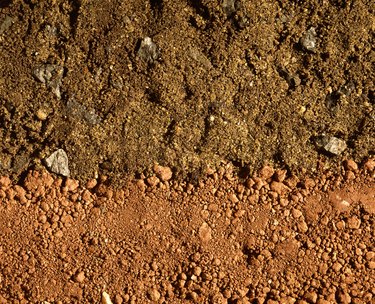
Soil leaching is a concern for farmers and gardeners everywhere. A naturally occurring process, soil leaching is unavoidable and necessary for healthy soil and crop growth. However, as with many things, too much of a good thing can lead to significant problems in soil and groundwater.
What Is Soil Leaching?
Video of the Day
Leaching refers to water moving through the soil, carrying with it nutrients for the plants. The water picks up minerals and other plant nutrients, while the breakdown of organic materials on the surface replenishes the minerals lost. This process is naturally occurring, and it is most frequently caused by the after effects of rainfall.
Video of the Day
However, heavy rainfall can also cause adverse effects, and one of these is known as soil acidification. Agriculture plant production requires soil at a certain pH level to yield the best results, which is also valid for homegrown plants. When heavy rainfall causes increased levels of leaching, nitrate content gets removed from the soil at a rate that is too fast for the natural processes to replenish. As a result, the pH level drops, and the leached soil become too acidic to promote plant life. Soil acidification can also alter soil microbes, contaminate surface water and decrease the earthworm population.
What Are the Effects of Leaching?
In addition to soil acidification, groundwater contamination is one of the equally troubling effects of soil leaching. Soil leaching not only involves nutrient leaching but can also pick up pesticides. Most pesticides are absorbed by soil particles and become immobile, so leaching does not pick them up. However, the pesticides that do not get absorbed are left mobile and can travel to the groundwater.
Because groundwater does not perpetually dilute itself like running surface water, flushing contaminants from groundwater can take years. In addition to the lack of sunlight, limited microbiological activity and low oxygen levels ultimately slow the chemical breakdown. While it is not solely responsible, leaching can also promote erosion. Suppose there has been significant soil leaching in an area, leading to soil acidification and making it less hospitable to plants. As a result, poor root system development and decreased earth room populations make it easier for runoff and wind to remove the topsoil.
On the other hand, one effect that is not necessarily negative is salt removal. High salt levels in the soil can make it difficult for seeds to germinate. Through controlled leachings, such as irrigation, salt levels get reduced to create a more hospitable soil for crops.
What Conditions Promote Soil Leaching?
Certain conditions can make soil leaching more likely to occur in specific areas than others. These soil conditions that affect leaching include organic matter, texture, structure and soil water content. Organic matter is considered to be the most crucial factor in soil leaching. When present in the soil, the organic matter provides more opportunities for absorption, increasing the amount of water the soil can hold, degrading pesticides and providing nutrients for microorganisms.
Soil texture also affects water movement. Coarse-textured soil allows water to move faster and easier, ultimately increasing the leaching rate, while clay-textured soil slows down the water movement. The structure also plays an integral role in the leaching rate. Loose soil allows water to rush through the soil, while tightly compacted soil will prevent the water from quickly moving and reaching the groundwater. However, burrows dug by earthworms and mammals can still promote leaching.
Lastly, the soil water content can increase the likelihood of soil leaching. When the soil is saturated or near saturation, soluble chemicals are more likely to leach into the groundwater.